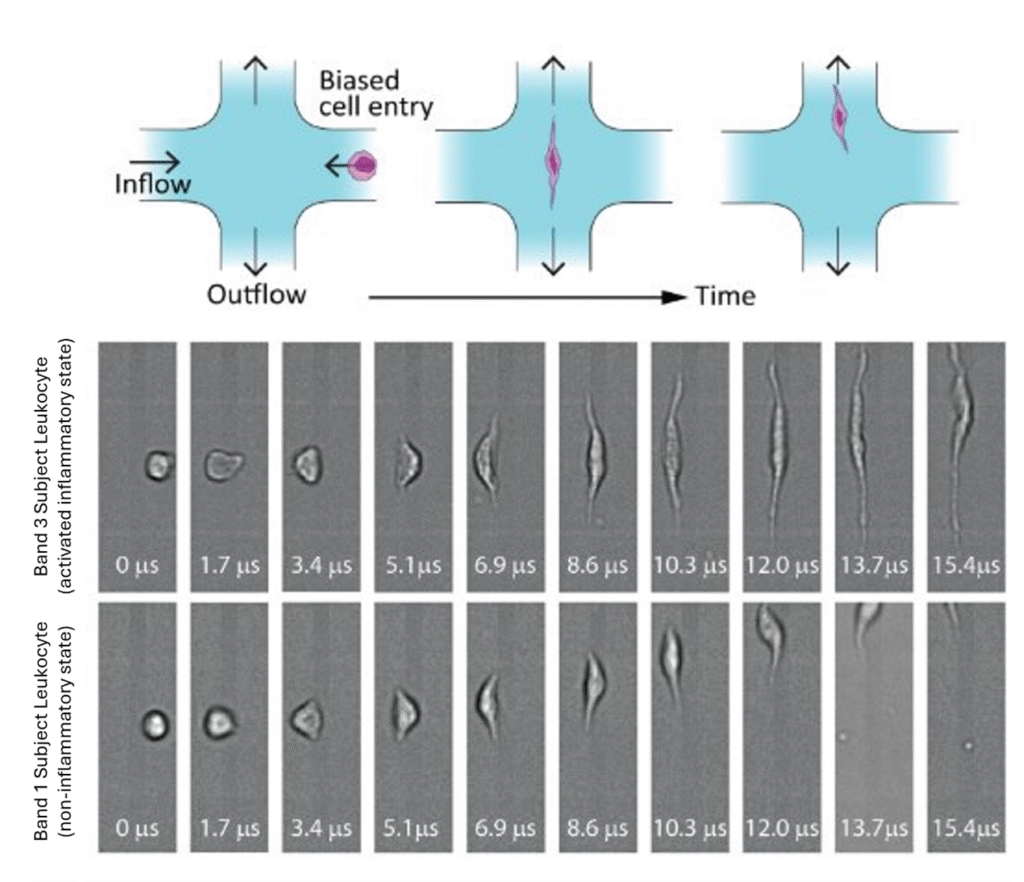Deformability Cytometry: A Revolution in Sepsis Detection
Timely diagnosis is everything when it comes to sepsis. Traditional tests focus on identifying pathogens or inflammatory biomarkers in the blood. However, they often fall short in detecting the immune dysregulation that underlies sepsis, leading to diagnostic delays that cost lives. Each hour without appropriate treatment increases the risk of mortality by about 8%1—a statistic that puts enormous pressure on emergency departments (EDs).
Deformability cytometry offers a groundbreaking solution. By measuring how blood cells, especially white blood cells (WBCs), change shape under stress, this technology can detect sepsis-related immune activation in real time—well before traditional methods confirm infection.
This article explores how deformability cytometry is transforming sepsis risk assessment through mechanical phenotyping of immune cells. It also highlights how Cytovale’s IntelliSep test brings this innovation to clinical practice.
What Is Deformability Cytometry?
Deformability cytometry is an advanced, label-free approach that analyzes how individual cells deform when subjected to mechanical stress. Unlike conventional blood tests that rely on biochemical markers, this method focuses on the mechanical properties—such as cell stiffness, shape, and size—providing a powerful new lens into cell biology.
Using a microfluidic channel, blood cells are propelled against a fluid wall. High-speed imaging records their deformation, capturing thousands of cells per second. AI-powered analysis then converts this data into clinically relevant insights, revealing shifts in cell deformability linked to immune system activation.
Key Advantages:
• Speed: Delivers results in ~8 minutes, ideal for ED settings.
• Label-Free Simplicity: No dyes or reagents required.
• High Throughput: Analyzes thousands of cells per run.
• AI Integration: Machine learning interprets complex deformation patterns at scale.
These attributes make deformability cytometry a uniquely scalable and rapid method for assessing host immune response, especially in cases where time-sensitive action is critical.
Deformability Cytometry and Sepsis Risk Assessment
Early sepsis detection depends on recognizing immune dysregulation—a subtle but dangerous shift in blood cell behavior. Real time deformability cytometry excels at detecting these early biomechanical changes.
Mechanical Properties Analyzed
Cell Size and Shape
As cells pass through the device, their diameter and shape are analyzed. Activated immune cells—like neutrophils—may swell or become more pliable due to cytoskeletal changes. These mechanical traits are direct indicators of immune status.
Degree of Elongation and Granularity
The cell deformation index (often aspect ratio) reveals how much a cell elongates under stress. Septic patients often show higher elongation in neutrophils and monocytes, indicating inflammation. Additionally, cellular granularity—the internal complexity of cells—can reflect “toxic granulation,” a marker of immune hyperactivation.
Nuclear Mechanics
The nucleus is the stiffest part of many immune cells. Changes in nuclear structure, such as chromatin relaxation during NETosis, result in altered deformability. These insights offer a molecular-level view of immune alertness.

Sorrells, Matt G., et al. “Biophysical Changes of Leukocyte Activation (and NETosis) in the Cellular Host Response to Sepsis.” Diagnostics, 2023.
Why This Matters for Sepsis Detection
• Host-Focused: Rather than waiting for pathogen detection, deformability cytometry assesses the mechanical properties of the host’s own cells—ideal when cultures are slow or inconclusive.
• Rapid Turnaround: An 8-minute result can drastically reduce ED decision-making time.
• Sensitive to Early Immune Changes: Captures shifts in cell stiffness and structure that precede other clinical signs.
By focusing on the mechanical phenotyping of immune cells, this technology provides a holistic snapshot of the body’s real-time response to infection.
The Cytovale System and IntelliSep Sepsis Test
Cytovale’s IntelliSep test utilizes deformability cytometry to assess sepsis risk based on blood cell mechanics. It’s the only FDA-cleared in vitro diagnostic of its kind, for use as an aid in the identification of sepsis in the ED.

Figure: Blood cell movement through microfluidic deformation junction
O’Neal, Hollis R., Jr., et al. “Assessment of a Cellular Host Response Test as a Sepsis Diagnostic for Those With Suspected Infection in the Emergency Department.” Critical Care Explorations, 2021.
IntelliSep Index (ISI) Bands:
• Band 1: Low likelihood of sepsis – likely no further workup needed.
• Band 2: Further clinical evaluation recommended.
• Band 3: High likelihood of sepsis – initiate protocols urgently.
How It Works:
1. Sample Collection: A 100µL aliquot of a purple top venous blood sample is introduced into the Cytovale System.
2. Mechanical Stressing: The cells are deformed using real time deformability cytometry.
3. High-Speed Imaging: Captures cell deformation at hundreds of thousands of frames/second.
4. AI Analysis: Quantifies cell deformability, elongation, granularity, and nuclear response.
5. Rapid Output: Delivers the ISI score in about 8 minutes.
Clinical Integration & Applications
• ED Workflow-Friendly: Minimal sample prep and quick integration into existing protocols.
• Broad Utility: Applies across infection types (bacterial, viral, fungal).
• Operational Efficiency: Supports early triage, better allocation of resources, and faster intervention.
By bridging the gap between immunology and cell mechanics, Cytovale’s IntelliSep test empowers ED clinicians to act swiftly, using biological insights that other tests may miss.
Conclusion
Deformability cytometry represents a significant leap in both cytometry and sepsis care. It translates subtle shifts in cell stiffness, shape, and internal architecture into actionable clinical data. This real time view of immune activity—powered by mechanical phenotyping—offers earlier, faster, and more accurate detection of sepsis risk.
As sepsis continues to be a leading cause of mortality, innovations like Cytovale’s IntelliSep test can reshape how clinicians approach diagnosis and intervention in the ED.
Click here to learn more about IntelliSep and Cytovale’s approach to sepsis detection.
References
1. Kumar A, Roberts D, Wood KE, et al. Duration of hypotension before initiation of effective antimicrobial therapy is the critical determinant of survival in human septic shock. Crit Care Med. 2006;34(6):1589-1596. doi:10.1097/01.CCM.0000217961.75225.E9